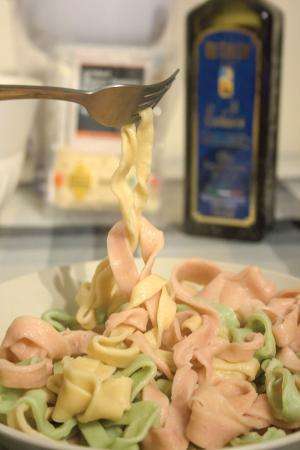Physicists create new kind of pasta to explain mysterious, ring-shaped polymers

Two physicists from the University of Warwick have taken to the kitchen to explain the complexity surrounding what they say is one of the last big mysteries in polymer physics.
As a way of demonstrating the complicated shapes that ring-shaped polymers can adopt, the researchers have created a brand new type of ring-shaped pasta, dubbed "anelloni" (anello being the Italian word for "ring"), which they've exclusively unveiled in this month's Physics World.
With just 2 eggs and 200 g of plain flour, Davide Michieletto and Matthew S Turner have created large loops of pasta that, when cooked and thrown together in a bowl, get hugely tangled up, in much the same way that ring-shaped polymers become massively intertwined with each other.
A video of Davide Michieletto showing what it's like to eat this new kind of pasta was taken at the headquarters of Physics World.
Whereas it's easy when faced with a bowl of normal spaghetti to suck or pull a single strand out, it's much harder to extract a single piece of pasta from a pile of anelloni, which get horribly tangled up.
"The thing about ring-shaped polymers...is that they're very poorly understood - in fact, they're one of the last big mysteries in polymer physics," the researchers write.
While the new kind of pasta is just a bit of fun, Michieletto and Turner's real work involves carrying out computer simulations of ring-shaped polymers, which have shown that if molecules are long enough, they are likely to get so tangled up that that they would appear frozen in place.
If this were true in real life - and there is some evidence to suggest that it is - then they believe they would have discovered a new state of matter, which they have called a "topological glass".
An ordinary glassy material is fashioned when a viscous liquid is cooled far enough that the molecules eventually stop moving and are frozen in place - they maintain the disordered structure of a liquid but develop the mechanical properties of a solid.
Plastic bottles, for example, are glassy materials that are set into shape when ordinary polymers - the building blocks of plastics - are rapidly cooled.
For a "topological glass" made from ring-shaped polymers, the motion of the individual molecules would slow down not just with temperature but also ring length, which Michieletto and Turner believe could inspire novel materials with applications that we cannot yet imagine.
"What would be nice about a topological glass is that its properties would be governed purely by topology, rather than the system-specific chemical details that often control when and how classical glasses form. Physicists love that kind of universal behaviour - in fact, obtaining a universal description of glasses has been a central goal in condensed-matter physics for several decades," they write.
While Michieletto and Turner wait for news on whether they've been granted more supercomputer time to push their simulations to the limit and learn more about these mysterious ring-shaped polymers, they can sit back and pass the time by picking apart a bowl of delicious, home-cooked anelloni.
"[W]hen it comes to eating pasta, the Italians were right all along - you're better off sticking to spaghetti, which you can eat nice and quickly. Make yourself a bowl of anelloni and it's likely to have gone cold by the time you've pulled all the rings apart and struggled your way to the messy end," they conclude.
Journal information: Physics World
Provided by Institute of Physics





















